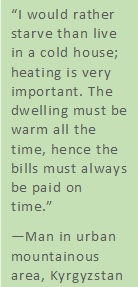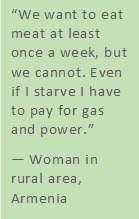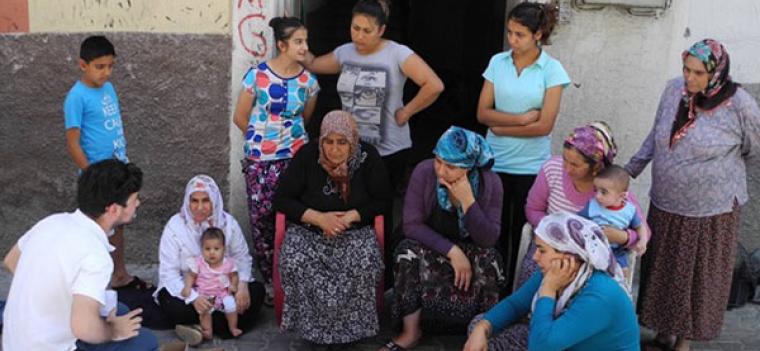News
- Energy subsidy reforms, and resulting tariff hikes, have led to large public dissatisfaction and social unrest across Europe and Central Asia.
- Rising costs of energy affect a wide share of the population—poor, near poor, as well as middle class. To cope with higher energy costs, households tend to reduce spending on other basic necessities such as food, clothing, and adequate heating.
- Collecting continuous citizen feedback and supporting effective and affordable energy efficiency measures are some of the ways in which governments can introduce a reform path that is both financially sustainable and acceptable to the public.
Countries in Europe and Central Asia have undertaken a wide range of energy sector reforms since the 1990s; however, progress across the region has been slow and uneven. Countries in this region experience long and cold winters. This makes it hard for citizens to save energy, especially since many live in housing that is poorly insulated. Citizens in these countries have historically paid very little for energy, and many believe it is the government’s job to make sure energy remains affordable. In addition, citizens in these countries often believe they should receive cheap energy because they are partial owners of the country’s natural resources. This combination of impacts and expectations often results in discontent when energy prices rise. Discontent leads to protests, which have derailed the implementation of reforms.
In 2013 and 2014, the World Bank conducted 208 focus group discussions across eight countries in Europe and Central Asia. The resulting report, “Adapting to Higher Energy Costs: Findings from Qualitative Studies in Europe and Central Asia,” examines households’ experiences with and attitudes toward energy tariff reforms.
So what can we draw from what the households shared with us?
-
 Energy price increases are hardest on the poor but also have palpable impacts on near poor andmiddle-income households. Heating, which is essential during the long months and cold temperatures that characterize winter in the ECA, often represents the highest household energyexpense, and winter months pose the greatest burden on the household budget. To afford heating with rising fuel prices, both poor and middle-income households report they need to cut spending on food, new clothing, and to stop attending social activities. Periods of economic downturn coupled with employment in the informal sector additionally reduce households’ ability to cope with higher energy payments. Many households choose to only partially heat their homes. This leads to more crowded living conditions in the winter, and has negative health impacts e.g. from not heating the house during the day when only one or few household members are at home.
Energy price increases are hardest on the poor but also have palpable impacts on near poor andmiddle-income households. Heating, which is essential during the long months and cold temperatures that characterize winter in the ECA, often represents the highest household energyexpense, and winter months pose the greatest burden on the household budget. To afford heating with rising fuel prices, both poor and middle-income households report they need to cut spending on food, new clothing, and to stop attending social activities. Periods of economic downturn coupled with employment in the informal sector additionally reduce households’ ability to cope with higher energy payments. Many households choose to only partially heat their homes. This leads to more crowded living conditions in the winter, and has negative health impacts e.g. from not heating the house during the day when only one or few household members are at home. -
Maintaining energy affordability during subsidy and tariff reforms depends on a variety of factors beyond income. Prices of fuels and energy services may vary by region, so the location in which one lives can be a strong determinant of the way a household can cope with rising energy. The amount of energy needed for heating may also vary depending on the location and type of housing. Income security is another important factor in the way households perceive their ability to cope with higher energy costs; it also creates distinct vulnerabilities. For example, in countries such as Tajikistan remittances play a strong role in the ability of a household to afford fuels for the winter. Households without a migrant or abandoned by the migrant (the latter, mostly female-headed) are at a much higher risk of not being able to secure fuels for heating or pay their energy bill. Being aware of these context-specific vulnerabilities can help improve the effectiveness of safety nets.
-
Energy-saving measures are expensive and largely out of poorer households’ reach. The majority of interviewed households have put some measures in place to save energy—ranging from basic measures, such as lining walls with carpets and windows with plastic sheets, to more advanced ones, such as replacing window and door frames, wall insulation, and buying more energy efficient appliances. As lower-income households cannot afford more advanced energy efficiency improvements, saving energy for them directly translates into compromising heating comfort, quality of lighting, cooking fuels, or use of basic appliances. Higher income households are better able to save energy without it encroaching on their basic needs. Affordable energy efficiency options are thus essential to promote better energy-saving behavior
-
Social assistance systems do not always mitigate against the impacts of rising energy costs for the poor. ECA countries usually have mechanisms in place to help low-income households make energy payments, and households that rely on these benefits consider them an essential form of support. However, these benefits only reach a limited proportion of the poorest households. Respondents voice concerns regarding benefits’ lack of transparent eligibility criteria, unclear regulations, complex application process, and/or applicants’ poor communication with social workers.
What can governments do respond to those concerns?
-
Governments should continue improving social assistance systems to ensure that they mitigate the impacts of rising energy
 prices on the poorest citizens. Improvements in targeting, fraud prevention, and eliminating exclusion errors are important steps in that direction. At the same time, policy-makers should be aware of the range of factors that affect vulnerability to tariff increases to makesure that safety nets respond to the needs of the most vulnerable. For example, seasonal flexibility in the timing of benefits—making households able to purchase wood or gas in bulk in warmer months when prices are lower, or afford higher payments during winters—can make it easier for households to manage expenses without increasing costs for the state.
prices on the poorest citizens. Improvements in targeting, fraud prevention, and eliminating exclusion errors are important steps in that direction. At the same time, policy-makers should be aware of the range of factors that affect vulnerability to tariff increases to makesure that safety nets respond to the needs of the most vulnerable. For example, seasonal flexibility in the timing of benefits—making households able to purchase wood or gas in bulk in warmer months when prices are lower, or afford higher payments during winters—can make it easier for households to manage expenses without increasing costs for the state. -
Last-resort social programs are not sufficient to mitigate the broad consequences of these reforms. Energy-efficiency measures are an important mitigation measure to improve energy affordability in the long term for all social groups. Energy-efficiency support programs should be more accessible to lower-income households, which often cannot access such support due to associated upfront costs and credit and co-financing requirements they are unable to meet. Middle-income households are currently better positioned to reap the benefits of energy-efficiency investments because they have better information about them and are able to commit their own financial resources to adopting them.
About the Author
Sophia V. Georgieva is a Social Development Specialist at the World Bank’s Urban, Rural and Social Development Global Practice, where she has worked for the past ten years. Her areas of expertise are in qualitative research, poverty and social impact analysis of reforms, social inclusion, and social safeguards. She has conducted multiple social assessment studies across sectors, including energy, water, and transport reforms, climate change adaptation, social inclusion of gender, youth, and minorities in ECA and LCR regions. Over the past three years Sophia has conducted research across Europe and Central Asia region on social impacts of energy subsidy and reforms, resulting in two World Bank publications: “Adapting to Higher Energy Costs: Findings from Qualitative Studies in Europe and Central Asia” and “Toward Gender Informed Energy Subsidy Reforms.”
ESMAP | Energy Subsidy Reform Online Community (ESROC) | Practitioner Exchange Series
